Integrated Hydrological Modeling to Analyze the Effects of Precipitation on Surface Water and Groundwater Hydrologic Processes in a Small Watershed
Abstract
1. Introduction
2. Materials and Methods
2.1. Study Area
2.2. Integrated Hydrological Modeling—MIKE SHE
2.3. Input Data
2.4. Sensitivity Analysis
2.5. Model Calibration Parameters Optimization
2.6. Model Performance Analysis
2.7. Effect of Precipitation Sources on Groundwater and Surface Water Flows
2.7.1. Sensitive Variable (i.e., Groundwater Elevations or Surface Water Flows)
2.7.2. Seasonal Variations of Difference in Surface Water Flow with Respect to Change in Precipitation
3. Results
3.1. Model Performance
3.1.1. Model Calibration and Validation
3.1.2. NOAA-Edwardsville Vs NOAA-St. Louis
3.2. Effect of Precipitation on Groundwater and Surface Water Flows
3.2.1. Sensitive Variable (i.e., Groundwater Elevations or Surface Water Flows)
3.2.2. Seasonal Variations of Difference in Surface Water Flow with Respect to Change in Precipitation
4. Discussion
4.1. Model Performance
4.2. Effects of Precipitation on Groundwater and Surface Water
4.3. Study Application
5. Conclusions
Author Contributions
Funding
Data Availability Statement
Acknowledgments
Conflicts of Interest
References
- Gordon, L.J.; Finlayson, C.M.; Falkenmark, M. Managing water in agriculture for food production and other ecosystem services. Agric. Water Manag. 2010, 97, 512–519. [Google Scholar] [CrossRef]
- Ma, C.; Zhang, G.Y.; Zhang, X.C.; Zhou, B.; Jiang, W.X. Water resource management for wetland restoration engineering in Tianjin coastal area in China. Adv. Mater. Res. 2012, 518, 4333–4336. [Google Scholar] [CrossRef]
- Benjankar, R.; Jorde, K.; Yager, E.M.; Egger, G.; Goodwin, P.; Glenn, N.F. The Impact of River Modification and Dam Operation on Floodplain Vegetation Succession Trends in the Kootenai River, USA. Ecol. Eng. 2012, 46, 88–97. [Google Scholar] [CrossRef]
- Benjankar, R.; Tranmer, A.W.; Vidergar, D.; Tonina, D. Riparian vegetation model to predict seedling recruitment and restoration alternatives. J. Environ. Manag. 2020, 276, 111339. [Google Scholar] [CrossRef]
- Dai, Z.; Li, C.; Trettin, C.; Sun, G.; Amatya, D.; Li, H. Bi-criteria evaluation of the MIKE SHE model for a forested watershed on the South Carolina coastal plain. Hydrol. Earth Syst. Sci. 2010, 14, 1033–1046. [Google Scholar] [CrossRef]
- Ruelland, D.; Ardoin-Bardin, S.; Billen, G.; Servat, E. Sensitivity of a lumped and semi-distributed hydrological model to several methods of rainfall interpolation on a large basin in West Africa. J. Hydrol. 2008, 361, 96–117. [Google Scholar] [CrossRef]
- Harbaugh, A.W. MODFLOW-2005: The US Geological Survey Modular Ground-Water Model: The Ground-Water Flow Process; US Geological Survey Reston: Reston, VA, USA, 2005. [Google Scholar]
- Sahoo, G.; Ray, C.; De Carlo, E. Calibration and validation of a physically distributed hydrological model, MIKE SHE, to predict streamflow at high frequency in a flashy mountainous Hawaii stream. J. Hydrol. 2006, 327, 94–109. [Google Scholar] [CrossRef]
- Graham, D.N.; Butts, M.B. Flexible, integrated watershed modelling with MIKE SHE. Watershed Models 2005, 849336090, 245–272. [Google Scholar]
- Doummar, J.; Sauter, M.; Geyer, T. Simulation of flow processes in a large scale karst system with an integrated catchment model (Mike She)—Identification of relevant parameters influencing spring discharge. J. Hydrol. 2012, 426, 112–123. [Google Scholar] [CrossRef]
- Madsen, H.; Jacobsen, T. Automatic calibration of the MIKE SHE integrated hydrological modelling system. In Proceedings of the 4th DHI Software Conference, Helsingor, Denmark, 6–8 June 2001; pp. 6–8. [Google Scholar]
- Refsgaard, J.C. Parameterisation, calibration and validation of distributed hydrological models. J. Hydrol. 1997, 198, 69–97. [Google Scholar] [CrossRef]
- Oogathoo, S. Runoff Simulation in the Canagagigue Creek Watershed using the MIKE SHE Model. Master’s Thesis, McGill University, Montreal, QC, Canada, August 2006. [Google Scholar]
- Arnold, J.; Allen, P.; Volk, M.; Williams, J.; Bosch, D. Assessment of different representations of spatial variability on SWAT model performance. Trans. ASABE 2010, 53, 1433–1443. [Google Scholar] [CrossRef]
- Price, K.; Purucker, S.T.; Kraemer, S.R.; Babendreier, J.E.; Knightes, C.D. Comparison of radar and gauge precipitation data in watershed models across varying spatial and temporal scales. Hydrol. Process. 2014, 28, 3505–3520. [Google Scholar] [CrossRef]
- Fu, S.; Sonnenborg, T.O.; Jensen, K.H.; He, X. Impact of precipitation spatial resolution on the hydrological response of an integrated distributed water resources model. Vadose Zone J. 2011, 10, 25–36. [Google Scholar] [CrossRef]
- Vischel, T.; Lebel, T. Assessing the water balance in the Sahel: Impact of small scale rainfall variability on runoff. Part 2: Idealized modeling of runoff sensitivity. J. Hydrol. 2007, 333, 340–355. [Google Scholar] [CrossRef]
- Strauch, M.; Bernhofer, C.; Koide, S.; Volk, M.; Lorz, C.; Makeschin, F. Using precipitation data ensemble for uncertainty analysis in SWAT streamflow simulation. J. Hydrol. 2012, 414, 413–424. [Google Scholar] [CrossRef]
- Zhang, W.; Montgomery, D.R. Digital elevation model grid size, landscape representation, and hydrologic simulations. Water Resour. Res. 1994, 30, 1019–1028. [Google Scholar] [CrossRef]
- Smith, M.B.; Koren, V.I.; Zhang, Z.; Reed, S.M.; Pan, J.-J.; Moreda, F. Runoff response to spatial variability in precipitation: An analysis of observed data. J. Hydrol. 2004, 298, 267–286. [Google Scholar] [CrossRef]
- Berne, A.; Delrieu, G.; Creutin, J.-D.; Obled, C. Temporal and spatial resolution of rainfall measurements required for urban hydrology. J. Hydrol. 2004, 299, 166–179. [Google Scholar] [CrossRef]
- McGregor, G.R.; Nieuwolt, S. Tropical Climatology: An Introduction to the Climates of the Low Latitudes; John Wiley & Sons Ltd.: Chichester, UK, 1998. [Google Scholar]
- Singh, P.; Kumar, N. Effect of orography on precipitation in the western Himalayan region. J. Hydrol. 1997, 199, 183–206. [Google Scholar] [CrossRef]
- Marino, P.; Comegna, L.; Damiano, E.; Olivares, L.; Greco, R. Monitoring the Hydrological Balance of a Landslide-Prone Slope Covered by Pyroclastic Deposits over Limestone Fractured Bedrock. Water 2020, 12, 3309. [Google Scholar] [CrossRef]
- Greco, R.; Comegna, L.; Damiano, E.; Marino, P.; Olivares, L.; Santonastaso, G.F. Recurrent rainfall-induced landslides on the slopes with pyroclastic cover of Partenio Mountains (Campania, Italy): Comparison of 1999 and 2019 events. Eng. Geol. 2021, 288, 106160. [Google Scholar] [CrossRef]
- Yeh, H.-F.; Lee, C.-H. Soil water balance model for precipitation-induced shallow landslides. Environ. Earth Sci. 2013, 70, 2691–2701. [Google Scholar] [CrossRef]
- Masih, I.; Maskey, S.; Uhlenbrook, S.; Smakhtin, V. Assessing the impact of areal precipitation input on streamflow simulations using the SWAT Model 1. JAWRA J. Am. Water Resour. Assoc. 2011, 47, 179–195. [Google Scholar] [CrossRef]
- Bredesen, A.; Brown, C. Comparison of Hydrologic Model Performance Statistics Using Rain Gauge and NEXRAD Precipitation Input at Different Watershed Spatial Scales and Rainfall Return Frequencies for the Upper St. Johns River, Florida USA. Proceedings 2018, 7, 11. [Google Scholar] [CrossRef]
- Smith, T.M.; Arkin, P.A.; Ren, L.; Shen, S.S. Improved reconstruction of global precipitation since 1900. J. Atmos. Ocean. Technol. 2012, 29, 1505–1517. [Google Scholar] [CrossRef]
- Yu, M.; Chen, X.; Li, L.; Bao, A.; De la Paix, M.J. Streamflow simulation by SWAT using different precipitation sources in large arid basins with scarce raingauges. Water Resour. Manag. 2011, 25, 2669. [Google Scholar] [CrossRef]
- Cunha, L.K.; Mandapaka, P.V.; Krajewski, W.F.; Mantilla, R.; Bradley, A.A. Impact of radar-rainfall error structure on estimated flood magnitude across scales: An investigation based on a parsimonious distributed hydrological model. Water Resour. Res. 2012, 48, 1–22. [Google Scholar] [CrossRef]
- Moon, J.; Srinivasan, R.; Jacobs, J. Stream flow estimation using spatially distributed rainfall in the Trinity River basin, Texas. Trans. ASAE 2004, 47, 1445. [Google Scholar] [CrossRef]
- Obled, C.; Wendling, J.; Beven, K. The sensitivity of hydrological models to spatial rainfall patterns: An evaluation using observed data. J. Hydrol. 1994, 159, 305–333. [Google Scholar] [CrossRef]
- Bárdossy, A.; Das, T. Influence of rainfall observation network on model calibration and application. Hydrol. Earth Syst. Sci. 2008, 12, 77–89. [Google Scholar] [CrossRef]
- Radcliffe, D.; Mukundan, R. PRISM vs. CFSR precipitation data effects on calibration and validation of SWAT models. JAWRA J. Am. Water Resour. Assoc. 2017, 53, 89–100. [Google Scholar] [CrossRef]
- Molini, A.; Lanza, L.; La Barbera, P. The impact of tipping-bucket raingauge measurement errors on design rainfall for urban-scale applications. Hydrol. Process. Int. J. 2005, 19, 1073–1088. [Google Scholar] [CrossRef]
- Groisman, P.Y.; Legates, D.R. The accuracy of United States precipitation data. Bull. Am. Meteorol. Soc. 1994, 75, 215–228. [Google Scholar] [CrossRef]
- Krajewski, W.; Smith, J.A. Radar hydrology: Rainfall estimation. Adv. Water Resour. 2002, 25, 1387–1394. [Google Scholar] [CrossRef]
- Sirisena, T.A.J.G.; Maskey, S.; Ranasinghe, R.; Babele, M.S. Effects of different precipitation inputs on streamflow simulation in the Irrawaddy River Basin, Myanmar. J. Hydrol. Reg. Stud. 2018, 19, 265–278. [Google Scholar] [CrossRef]
- Segond, M.-L.; Wheater, H.S.; Onof, C. The significance of spatial rainfall representation for flood runoff estimation: A numerical evaluation based on the Lee catchment, UK. J. Hydrol. 2007, 347, 116–131. [Google Scholar] [CrossRef]
- Bell, V.; Moore, R. The sensitivity of catchment runoff models to rainfall data at different spatial scales. Hydrol. Earth Syst. Sci. 2000, 4, 653–667. [Google Scholar] [CrossRef]
- Koren, V.; Finnerty, B.; Schaake, J.; Smith, M.; Seo, D.-J.; Duan, Q.-Y. Scale dependencies of hydrologic models to spatial variability of precipitation. J. Hydrol. 1999, 217, 285–302. [Google Scholar] [CrossRef]
- Fuka, D.; Walter, M.; MacAlister, C.; Degaetano, A.; Steenhuis, T.; Easton, Z. Using the climate forecast system reanalysis as weather input data for watershed models: Using CFSR as weather input data for watershed models. Hydrol. Process. 2014, 28, 5613–5623. [Google Scholar] [CrossRef]
- Najafi, M.R.; Moradkhani, H.; Piechota, T.C. Ensemble streamflow prediction: Climate signal weighting methods vs. climate forecast system reanalysis. J. Hydrol. 2012, 442–443, 105–116. [Google Scholar] [CrossRef]
- Smith, R.A.; Kummerow, C.D. A comparison of in situ, reanalysis, and satellite water budgets over the upper Colorado River basin. J. Hydrometeorol. 2013, 14, 888–905. [Google Scholar] [CrossRef]
- Goodarzi, M.; Amiri, B.J.; Azarneyvand, H.; Khazaee, M.; Mahdianzadeh, N. Assessing the performance of a hydrological tank model at various spatial scales. J. Water Manag. Modeling. 2020, 28, 1–8. [Google Scholar] [CrossRef]
- Lopes, V.L. On the effect of uncertainty in spatial distribution of rainfall on catchment modelling. Catena 1996, 28, 107–119. [Google Scholar] [CrossRef]
- Guo, J.; Liang, X.; Leung, L.R. Impacts of different precipitation data sources on water budgets. J. Hydrol. 2004, 298, 311–334. [Google Scholar] [CrossRef]
- Carpenter, T.M.; Georgakakos, K.P. Impacts of parametric and radar rainfall uncertainty on the ensemble streamflow simulations of a distributed hydrologic model. J. Hydrol. 2004, 298, 202–221. [Google Scholar] [CrossRef]
- Vitola, I.; Vircavs, V.; Abramenko, K.; Lauva, D.; Veinbergs, A. Precipitation and Air Temperature Impact on Seasonal Variations of Groundwater Levels. Environ. Clim. Technol. 2012, 10, 25–33. [Google Scholar] [CrossRef][Green Version]
- Wu, W.-Y.; Lo, M.-H.; Wada, Y.; Famiglietti, J.S.; Reager, J.T.; Yeh, P.J.-F.; Ducharne, A.; Yang, Z.-L. Divergent effects of climate change on future groundwater availability in key mid-latitude aquifers. Nat. Commun. 2020, 11, 3710. [Google Scholar] [CrossRef]
- Haucke, J. Precipitation and Pumping Effects on Groundwater Levels in Central Wisconsin; University of Wisconsin: Stevens Point, WI, USA, 2010. [Google Scholar]
- Ayers, J.R.; Villarini, G.; Jones, C.; Schilling, K. Changes in monthly baseflow across the U.S. Midwest. Hydrol. Process. 2019, 33, 748–758. [Google Scholar] [CrossRef]
- Refsgaard, J.C.; Højberg, A.L.; Møller, I.; Hansen, M.; Søndergaard, V. Groundwater modeling in integrated water resources management—Visions for 2020. Groundwater 2010, 48, 633–648. [Google Scholar] [CrossRef]
- Danish Hydraulic Institute (DHI). MIKE SHE User Guide; DHI: Hørsholm, Denmark, 2017. [Google Scholar]
- Bogdanov, L.; Zakharov, V. The Boussinesq equation revisited. Phys. D Nonlinear Phenom. 2002, 165, 137–162. [Google Scholar] [CrossRef]
- Kristensen, K.; Jensen, S. A model for estimating actual evapotranspiration from potential evapotranspiration. Hydrol. Res. 1975, 6, 170–188. [Google Scholar] [CrossRef]
- Thompson, J.; Sørenson, H.R.; Gavin, H.; Refsgaard, A. Application of the coupled MIKE SHE/MIKE 11 modelling system to a lowland wet grassland in southeast England. J. Hydrol. 2004, 293, 151–179. [Google Scholar] [CrossRef]
- Gaur, S.; Bandyopadhyay, A.; Singh, R. Projecting land use growth and associated impacts on hydrological balance through scenario-based modelling in the Subarnarekha basin, India. Hydrol. Sci.J. 2021, 66, 1997–2010. [Google Scholar] [CrossRef]
- Refsgaard, J.C.; Storm, B. Computer Models of Watershed Hydrology; Singh, V.P., Ed.; Water Resource Publications, LLC: Littleton, CO, USA, 1995; pp. 809–846. [Google Scholar]
- Saha, S.; Moorthi, S.; Pan, H.-L.; Wu, X.; Wang, J.; Nadiga, S.; Tripp, P.; Kistler, R.; Woollen, J.; Behringer, D.; et al. The NCEP climate forecast system reanalysis. Am. Meteorol. Soc. 2010, 91, 1015–1058. [Google Scholar] [CrossRef]
- Synder, R.L.; Eching, S. Daily Reference Evapotranspiration Calculator User’s Guide for PMday.xls; University of California: Oakland, CA, USA, 2006. [Google Scholar]
- Schwarz, G.E.; Alexander, R. State Soil Geographic (STATSGO) Data Base for the Conterminous United States; Open-File Report; USGS: Reston, VA, USA, 1995.
- Van Genuchten, M.T. A closed-form equation for predicting the hydraulic conductivity of unsaturated soils. Soil Sci. Soc. Am. J. 1980, 44, 892–898. [Google Scholar] [CrossRef]
- Im, S.; Kim, H.; Kim, C.; Jang, C. Assessing the impacts of land use changes on watershed hydrology using MIKE SHE. Environ. Geol. 2009, 57, 231. [Google Scholar] [CrossRef]
- Moriasi, D.; Wilson, B.; Douglas-Mankin, K.; Arnold, J.; Gowda, P. Hydrologic and water quality models: Use, calibration, and validation. Trans. ASABE 2012, 55, 1241–1247. [Google Scholar] [CrossRef]
- Zhang, Z.; Wang, S.; Sun, G.; McNulty, S.G.; Zhang, H.; Li, J.; Zhang, M.; Klaghofer, E.; Strauss, P. Evaluation of the MIKE SHE model for application in the Loess Plateau, China 1. JAWRA J. Am. Water Resour. Assoc. 2008, 44, 1108–1120. [Google Scholar] [CrossRef]
- Liu, H.-L.; Chen, X.; Bao, A.-M.; Wang, L. Investigation of groundwater response to overland flow and topography using a coupled MIKE SHE/MIKE 11 modeling system for an arid watershed. J. Hydrol. 2007, 347, 448–459. [Google Scholar] [CrossRef]
- Ogden, F.L.; Julien, P.Y. Runoff model sensitivity to radar rainfall resolution. J. Hydrol. 1994, 158, 1–18. [Google Scholar] [CrossRef]
- Komma, J.; Reszler, C.; Blöschl, G.; Haiden, T. Ensemble prediction of floods—Catchment non-linearity and forecast probabilities. Nat. Hazards Earth Syst. Sci. 2007, 7, 431–444. [Google Scholar] [CrossRef]
- Gupta, H.V.; Sorooshian, S.; Yapo, P.O. Status of automatic calibration for hydrologic models: Comparison with multilevel expert calibration. J. Hydrol. Eng. 1999, 4, 135–143. [Google Scholar] [CrossRef]
- Ritter, A.; Muñoz-Carpena, R. Performance evaluation of hydrological models: Statistical significance for reducing subjectivity in goodness-of-fit assessments. J. Hydrol. 2013, 480, 33–45. [Google Scholar] [CrossRef]
- Krause, P.; Boyle, D.; Bäse, F. Comparison of different efficiency criteria for hydrological model assessment. Adv. Geosci. 2005, 5, 89–97. [Google Scholar] [CrossRef]
- Willmott, C.J.; Matsuura, K. Advantages of the mean absolute error (MAE) over the root mean square error (RMSE) in assessing average model performance. Clim. Res. 2005, 30, 79–82. [Google Scholar] [CrossRef]
- Moriasi, D.N.; Gitau, M.W.; Pai, N.; Daggupati, P. Hydrologic and water quality models: Performance measures and evaluation criteria. Trans. ASABE 2015, 58, 1763–1785. [Google Scholar]
- Singh, J. Hydrologic Model of the Vermilion River Watershed for Streamflow Simulations; Illinois Department of Natural Resources and the Illinois State Geological Survey: Champaign, IL, USA, 2004.
- Sultana, Z.; Coulibaly, P. Distributed modelling of future changes in hydrological processes of Spencer Creek watershed. Hydrol. Process. 2011, 25, 1254–1270. [Google Scholar] [CrossRef]
- Qiu, L.-J.; Zheng, F.-L.; Yin, R.-S. SWAT-based runoff and sediment simulation in a small watershed, the loessial hilly-gullied region of China: Capabilities and challenges. Int. J. Sediment Res. 2012, 27, 226–234. [Google Scholar] [CrossRef]
- Krysanova, V.; Donnelly, C.; Gelfan, A.; Gerten, D.; Arheimer, B.; Hattermann, F.; Kundzewicz, Z.W. How the performance of hydrological models relates to credibility of projections under climate change. Hydrol. Sci. J. 2018, 63, 696–720. [Google Scholar] [CrossRef]
- Crochemore, L.; Isberg, K.; Pimentel, R.; Pineda, L.; Hasan, A.; Arheimer, B. Lessons learnt from checking the quality of openly accessible river flow data worldwide. Hydrol. Sci. J. 2020, 65, 699–711. [Google Scholar] [CrossRef]
- Pullen-Sansfaçon, A.; Spolander, G.; Engelbrecht, L. Migration of professional social workers: Reflections on challenges and strategies for education. Soc. Work. Educ. 2012, 31, 1032–1045. [Google Scholar] [CrossRef]
- Boughton, W. Calibrations of a daily rainfall-runoff model with poor quality data. Environ. Model. Softw. 2006, 21, 1114–1128. [Google Scholar] [CrossRef]
- Carpenter, T.M.; Georgakakos, K.P. Assessment of Folsom lake response to historical and potential future climate scenarios: 1. Forecasting. J. Hydrol. 2001, 249, 148–175. [Google Scholar] [CrossRef]
- Bulygina, N.; McIntyre, N.; Wheater, H. A comparison of rainfall-runoff modelling approaches forestimating impacts of rural land management onfloodflows. Hydrol. Res. 2013, 44, 467–483. [Google Scholar] [CrossRef]
- Paudel, S. Impact of Precipitation Sources on Surface Water and Groundwater Hydrology in Canteen-Cahokia Watershed, IL, USA; Southern Illinois University Edwardsville: Edwardsville, IL, USA, 2021. [Google Scholar]
- Vázquez, R.; Feyen, L.; Feyen, J.; Refsgaard, J. Effect of grid size on effective parameters and model performance of the MIKE-SHE code. Hydrol. Process. 2002, 16, 355–372. [Google Scholar] [CrossRef]
- Sohrabi, M.M.; Tonina, D.; Benjankar, R.; Kumar, M.; Kormos, P.; Marks, D. Role of temporal resolution of meteorological inputs for process-based snow modelling. Hydrol. Process. 2018, 32, 2976–2989. [Google Scholar] [CrossRef]
- Sohrabi, M.M.; Tonina, D.; Benjankar, R.; Kumar, M.; Kormos, P.; Marks, D.; Luce, C. On the role of spatial resolution on snow estimates using a process-based snow model across a range of climatology and elevation. Hydrol. Process. 2019, 33, 1260–1275. [Google Scholar] [CrossRef]
- United States Department of Agriculture (USDA). Urban Hydrology for Small Watersheds; United States Department of Agriculture (USDA): Washington, DC, USA, 1986; pp. 1–164.
- Célleri, R.; Timbe, L.; Vázquez, R.; Feyen, J. Assessment of the relation between the NAM rainfall-runoff model parameters and the physical catchment properties. HIP-VI UNESCO Tech. Doc. Hydrol. 2003, 66, 9–16. [Google Scholar]
- Singh, R.; Subramanian, K.; Refsgaard, J. Hydrological modelling of a small watershed using MIKE SHE for irrigation planning. Agric. Water Manag. 1999, 41, 149–166. [Google Scholar] [CrossRef]
- Tasser, E.; Mader, M.; Tappeiner, U. Effects of land use in alpine grasslands on the probability of landslides. Basic Appl. Ecol. 2003, 4, 271–280. [Google Scholar] [CrossRef]
- Christiaens, K.; Feyen, J. Analysis of uncertainties associated with different methods to determine soil hydraulic properties and their propagation in the distributed hydrological MIKE SHE model. J. Hydrol. 2001, 246, 63–81. [Google Scholar] [CrossRef]
- Gardner, P.M.; Heilweil, V.M. Evaluation of the Effects of Precipitation on Ground-Water Levels from Wells in Selected Alluvial Aquifers in Utah and Arizona, 1936–2005 U.S.; Geological Survey Scientific Investigations Report 2008-5242; USGS: Reston, VA, USA, 2009; p. 38.
- Garbrecht, J.; Liew, M.V.; Brown, G.O. Trends in Precipitation, Streamflow, and Evapotranspiration in the Great Plains of the United States. J. Hydrol. Eng. 2004, 9, 360–367. [Google Scholar] [CrossRef]
- Benjankar, R.; Tonina, D.; McKean, J.A.; Sohrabi, M.M.; Chen, Q.; Vidergar, D. An ecohydraulics virtual watershed: Integrating physical and biological variables to quantify aquatic habitat quality. Ecohydrology 2019, 12, e2062. [Google Scholar] [CrossRef]
- Benjankar, R.; Tonina, D.; Mckean, J.A.; Sohrabi, M.M.; Chen, Q.; Vidergar, D. Dam operations may improve aquatic habitat and offset negative effects of climate change. J. Environ. Manag. 2018, 213, 126–134. [Google Scholar] [CrossRef]
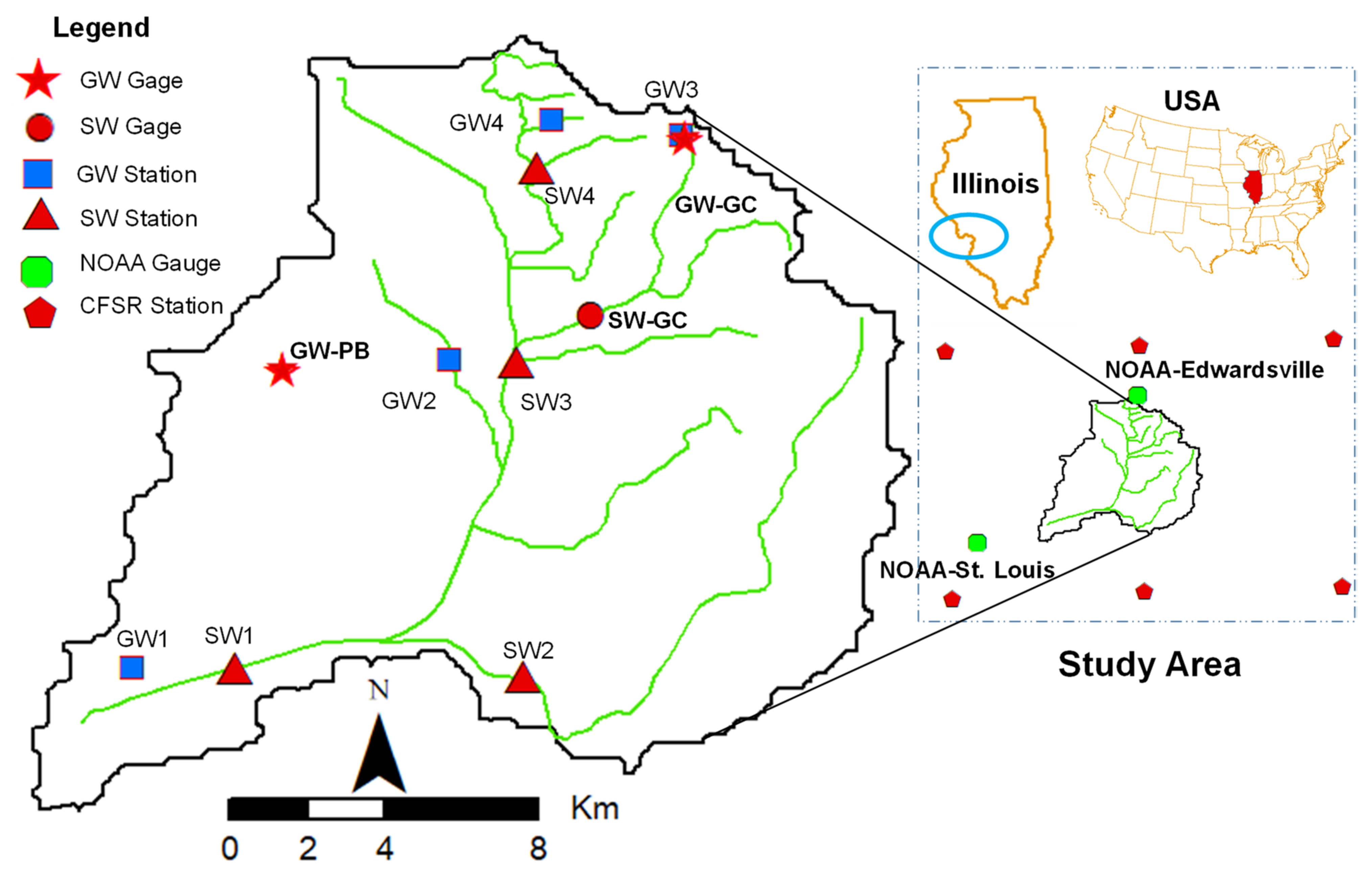

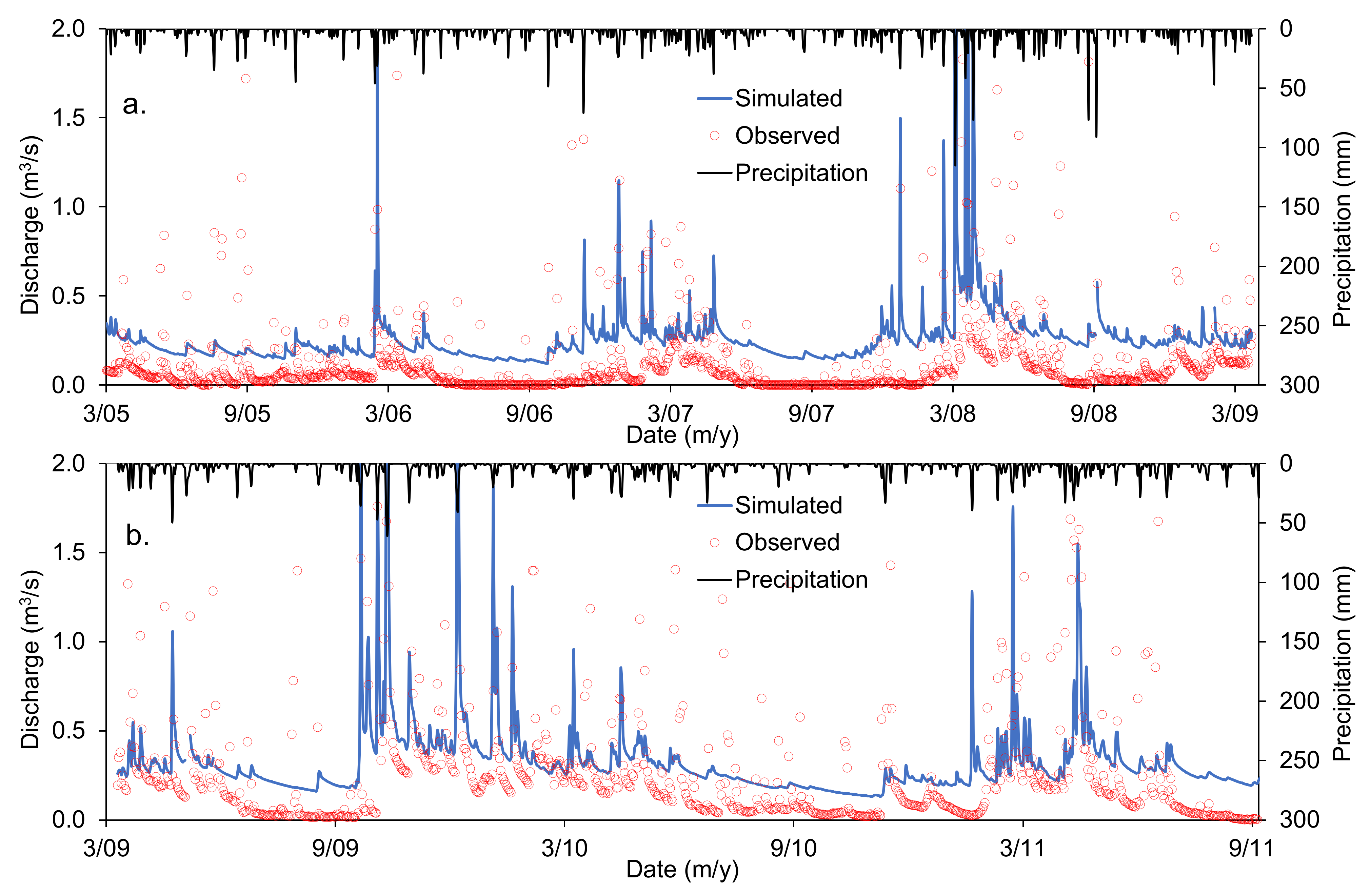
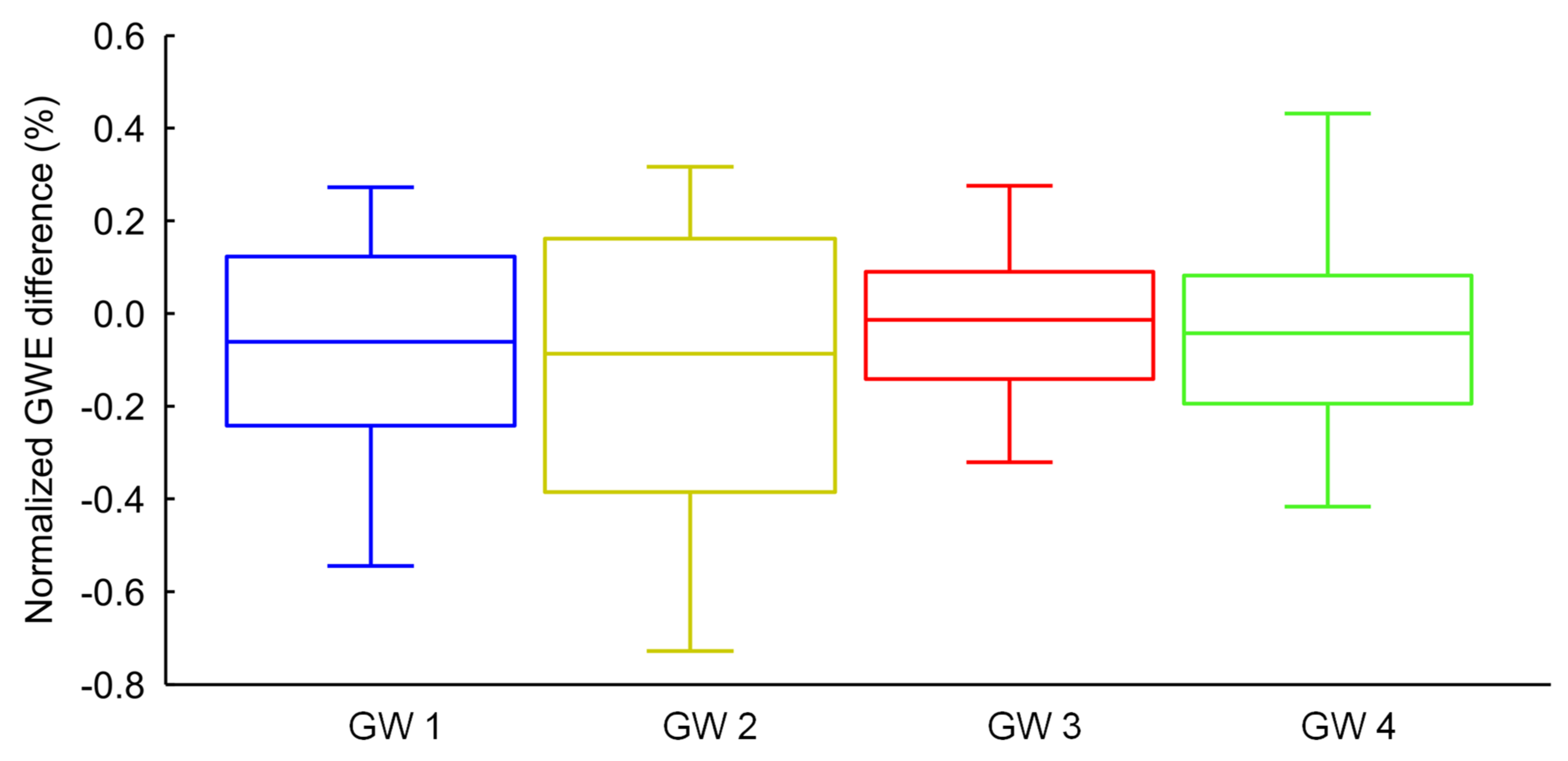
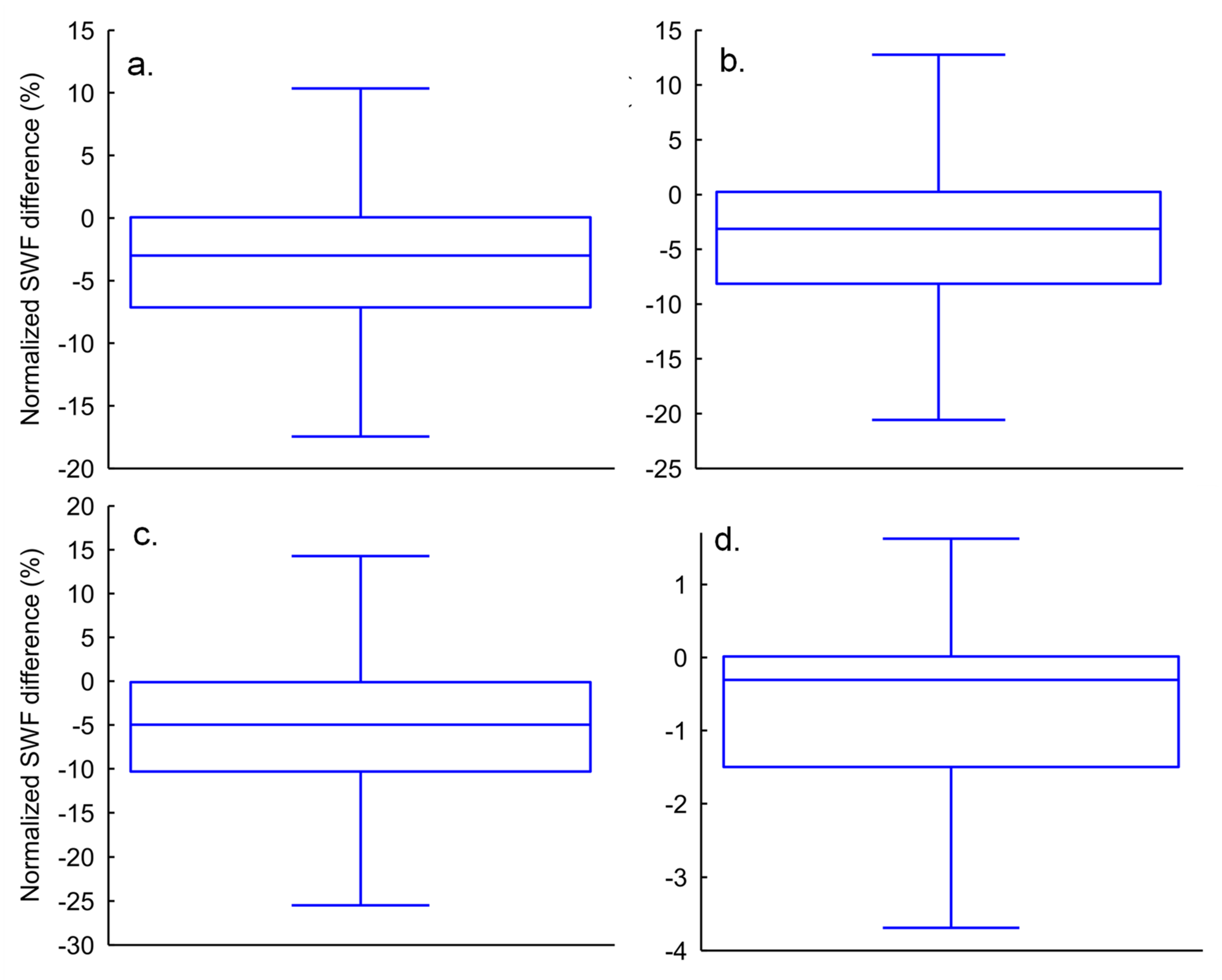
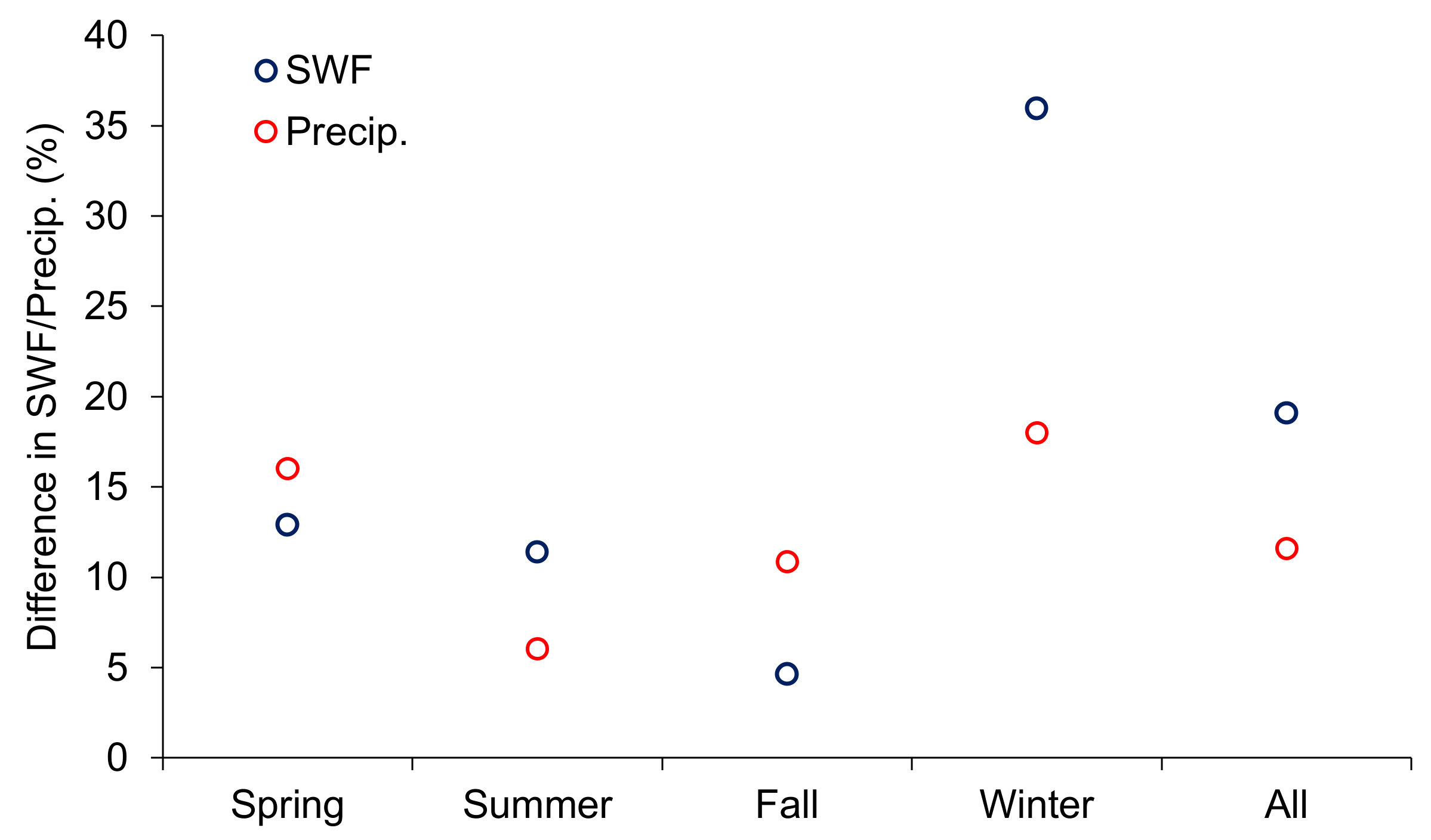

| Model | Parameters | Initial | Range | Calibrated |
|---|---|---|---|---|
| MIKE SHE | Overland and Unsaturated Zone | |||
| Manning’s M | 17 | 10–40 | 26.80 | |
| Detention Storage (mm) | 2 | 0–10 | 5.08 | |
| Bypass Constant | 0.26 | 0.15–0.9 | 0.27 | |
| Saturated Zone | ||||
| Horizontal Hydraulic Conductivity (10−6 m/s) | 5.6 | 0.0056–566 | 96.80 | |
| Vertical Hydraulic Conductivity (10−6 m/s) | 0.56 | 56.6 | 9.68 | |
| Specific Yield | 0.2 | 0.2–0.4 | 0.20 | |
| Initial Potential (−m) | 5 | 1–10 | 6.32 | |
| ET Parameters (Kristensen And Jensen) | ||||
| Canopy Interception (mm) | 0.05 | 0.05–0.4 | 0.07 | |
| C1 | 0.2 | 0.05–0.4 | 0.34 | |
| C2 | 0.2 | 0.05–0.4 | 0.06 | |
| C3 (mm/day) | 20 | 5–40 | 6.95 | |
| Aroot (/m) | 0.3 | 0.05–0.4 | 0.31 | |
| MIKE Hydro | River and Lakes | |||
| Manning’s M | 36 | 10–40 | 18.45 | |
| Leakage Coefficient (10−6) | 5.6 | 0.0056–566 | 2.30 | |
| Parameters | Calibration | Validation | ||
|---|---|---|---|---|
| GW-GC | SW-GC | GW-GC | SW-GC | |
| R | 0.74 | 0.80 | 0.74 | 0.65 |
| MAE (m, m3/s) | 0.45 | 0.20 | 0.39 | 0.22 |
| SD * | 0.65 | 0.44 | 0.53 | 0.57 |
| BIAS (m, m3/s) | 0.08 | −0.14 | −0.24 | −0.02 |
| NSE | 0.35 | 0.59 | 0.14 | 0.42 |
| Groundwater Elevation | ||||||
|---|---|---|---|---|---|---|
| NOAA-Edwardsville | Parameters | GW1 | GW2 | GW3 | GW4 | Average |
| R | 0.80 | 0.73 | 0.78 | 0.82 | 0.78 | |
| MAE (m) | 0.09 | 0.09 | 0.11 | 0.07 | 0.09 | |
| NOAA-St. Louis | R | 0.70 | 0.63 | 0.58 | 0.68 | 0.65 |
| MAE (m) | 0.03 | 0.10 | 0.23 | 0.21 | 0.15 | |
| Surface Water | ||||||
| NOAA-Edwardsville | Parameters | SW1 | SW2 | SW3 | SW4 | Average |
| R | 0.66 | 0.62 | 0.63 | 0.64 | 0.64 | |
| MAE (m3/s) | 1.02 | 0.38 | 0.02 | 0.03 | 0.78 | |
| NOAA-St. Louis | R | 0.46 | 0.38 | 0.34 | 0.45 | 0.41 |
| MAE (m3/s) | 0.91 | 0.31 | 0.02 | 0.02 | 0.68 | |
| Parameters | GW/SW1 | GW/SW2 | GW/SW3 | GW/SW4 | Average | |
|---|---|---|---|---|---|---|
| Groundwater | R | 0.80 | 0.73 | 0.78 | 0.82 | 0.78 |
| MAE (m) | 0.07 | 0.06 | 0.08 | 0.06 | 0.07 | |
| Surface Water | R | 0.72 | 0.64 | 0.65 | 0.63 | 0.66 |
| MAE (m3/s) | 5.22 | 9.61 | 0.81 | 11.19 | 6.71 |
Publisher’s Note: MDPI stays neutral with regard to jurisdictional claims in published maps and institutional affiliations. |
© 2022 by the authors. Licensee MDPI, Basel, Switzerland. This article is an open access article distributed under the terms and conditions of the Creative Commons Attribution (CC BY) license (https://creativecommons.org/licenses/by/4.0/).
Share and Cite
Paudel, S.; Benjankar, R. Integrated Hydrological Modeling to Analyze the Effects of Precipitation on Surface Water and Groundwater Hydrologic Processes in a Small Watershed. Hydrology 2022, 9, 37. https://doi.org/10.3390/hydrology9020037
Paudel S, Benjankar R. Integrated Hydrological Modeling to Analyze the Effects of Precipitation on Surface Water and Groundwater Hydrologic Processes in a Small Watershed. Hydrology. 2022; 9(2):37. https://doi.org/10.3390/hydrology9020037
Chicago/Turabian StylePaudel, Sabin, and Rohan Benjankar. 2022. "Integrated Hydrological Modeling to Analyze the Effects of Precipitation on Surface Water and Groundwater Hydrologic Processes in a Small Watershed" Hydrology 9, no. 2: 37. https://doi.org/10.3390/hydrology9020037
APA StylePaudel, S., & Benjankar, R. (2022). Integrated Hydrological Modeling to Analyze the Effects of Precipitation on Surface Water and Groundwater Hydrologic Processes in a Small Watershed. Hydrology, 9(2), 37. https://doi.org/10.3390/hydrology9020037







